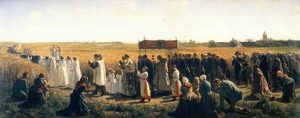
By Warren Drury
During August, the Congregation and Choir of the 10:30 Sunday Service will be experiencing the Psalms using plainsong chant tones. The plainsong tones are among the oldest music of the Christian Church and certain forms of it can be traced to the liturgical music of the Jewish synagogue. There are eight tones settings that are used with the Psalms. They are listed as “Tone (Roman Numeral)”. I.E. Tone VIII. Some also include a letter or numeric suffix where the end of the phrase notes pitches (cadences) are modified from the standard tone. These tones were incorporated for use with the Book of Common Prayer by John Merbecke in 1550. These Psalm settings are still sung in many larger congregations and cathedrals.
To appreciate and follow how to perform these tones, please click on links below.
Plainsong is essentially melody heightening a text. It is designed with a single line melody that does not include harmony that is repeated for each verse. The flow of the chant is governed by the natural flow of the words, rhythm, and phrasing of each verse. It should not be rushed. Please note that the notes without stems on the staff are only for pitch and not duration of each notes. The flow of the text and number of syllables determines the duration of the notes value. In traditional settings, the Psalm has special marking that connect the Words or Syllables to the music. This is know as Pointing. To make the transition to this style of Chanting the bulletins will be using conventional musical staffs with all the verses corresponding to their musical pitch. In later Psalm settings we may use the pointed Psalm Text with a single music line, which is the way it is typically shown in church music and bulletins.
The components of Plainsong Chanting includes the Antiphon, Intonation, Reciting Note and Cadence.
ANTIPHON
Plainsong Chants begin and end with an Antiphon. The text is a portion of a verse or summarizes a truth about the psalm.
The Antiphon precedes the Psalm and will be sung once by the Cantor and then repeated by all. (Fig. 1)
The Psalm begins with Intonation, sung by the Cantor. (Fig. 2 Pointed Structure of the Chant)
INTONATION
The first two syllables of the first line of the Psalm are paired with a few notes (with or without slurs) that introduce the recitation tone. The intonation notes only occur on the first verse. Subsequent verses begin with the reciting note.
Pointing: The Intonation words or syllables are italicized. If they have double dots over the words they are attached to the slurs in the Tone.
Sunday’s Psalm begins
RECITING NOTE
The notation for a reciting note is a Whole note or Lozenge or rectangular note symbol. The reciting note is the same tone in both halves for the Psalm verse. Dashes in the text indicates omission of the reciting note for that portion of the verse. The chanted reciting note text includes all words and syllables for the verse until an accent mark occurs over a word. This mark indicates the preceding word is the end of the reciting note and the word or syllable with the mark is the beginning of the cadence. For our convenience, we have modified the setting to show the relationship between the text and the notes. See Figure 4 for Reciting Note and Cadence
CADENCE
Each Verse is divided into two parts. The cadence before the asterisk “*” is called the Median Cadence and the portion after is called the Final Cadence. The half verses are also called Versicles. A Cadence consists of one or two accented syllables and one, two or three preparatory syllables. Accent marks in the psalm text (‘) word or syllable correspond to the accent marks under the notes in the psalm tone (‘). The notes in parenthesis are used only when needed. In a few cases, the verse ends with an accented syllable. In many cases this should be sung to the final accented note in the half of the psalm tone, omitting the note(s) in parentheses and the final note.
So to put it all together, here is the beginning of the Sunday’s Psalm 99. (See Fig 5 – Pointed Text Version and Fig. 6 for Conventional Version)








